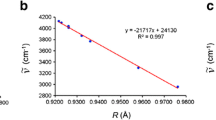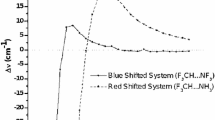Abstract
Theoretical adiabatic electron affinities are often considered inaccurate because they are referenced to only a single value. Ground state electron affinities for all the main group elements and homonuclear diatomics were identified recently using the normalized binding energy of the hydrogen atom: [0.75420375(3)/2 = 0.37710187(1) eV]. Here we revisit experimental values and extend the identifications to diatomics in the G2-1 set. We assign new ground state electron affinities: (eV) Cl2, 3.2(2); Br2, 2.87(14); CH, 2.1(2); H2, 0.6 ; NH, 1.1, SiH, 1.90. Anion Morse potentials are calculated for H2 and N2 from positive electron affinities and for hyperfine superoxide states for the first time.








Similar content being viewed by others
References
Chen ES, Chen ECM (2004) The electron capture detector and thermal electron reactions. Wiley, New York
Chen ES, Chen ECM (2007) Electron affinities and activation energies for reactions with thermal electrons: SF6 and SF5. Phys Rev A76:032508
Rienstra-Kiracofe JC, Tschumper GS, Schaefer HF, Nandi S, Ellison GB (2002) Atomic and molecular electron affinities: Photoelectron experiments and theoretical computations. Chem Rev 102:231–282
National Institute of Standards and Technology (NIST) Chemistry WebBook, [http://webbook.nist.gov/ and Cccbdb.nist.gov/ (accessed 2013)
Pritchard HO (1953) The determination of electron affinities. Chem Rev 52:529–563
Massey HSW (1950) Negative ions. Cambridge University Press, Cambridge
Lesk AM (1968) Use of the Hartree Fock approximation in calculating electron affinities. Phys Rev 171:7–10
Efimov V (1970) Energy levels arising from resonant two-body forces in a three-body system. Phys Lett B 33:563–564
Berry RS (1969) Small free negative ions. Chem Rev 69:533–542
Wildt R (1939) Electron affinity in astrophysics. Astrophys J 89:295–301
Hylleraas EA (1950) A new stable state of the negative hydrogen ion. Astrophys J 111:209–213
Hylleraas EA (1964) The negative hydrogen ion in quantum mechanics and astrophysics. Astrophysica Norvegica 9:345–349
Bethe HM (2012) http://www.webofstories.com/play/4483 , accessed 7 July 2012
Chen ES, Chen ECM (2013) The Hylleraas binding energy of hydride and electron affinities. J Theor Comp Chem 12:1350016
Chen ES, Herder C, Keith H, Chen ECM (2010) Hund’s strong field states of superoxide and NO(−). J Theor Comp Chem 9:1–8
Freeman RR (1971) I. Electron attachment to selected small molecules: II The development and charcterization of a photoionization/electron capture detector for use in gas chromatography systems. Doctoral dissertation, University of Houston
Chen ES, Chen ECM (2003) Semiempirical characterization of homonuclear diatomic ions: 6. group VI and VII anions. J Phys Chem A 107:169–177
Chen ECM, Herder C, Chang S, Ting R, Chen ES (2006) Experimental determination of spin–orbital coupling states of O2(−). J Phys B 39:2317–2333
Jalbout AF, De Leon A, Adamowicz L, Trzaskowski B, Chen ECM, Herder C, Chen ES (2007) Theoretical, empirical and experimental electron affinities of SF6: solving the density functional enigma. J Theor Comp Chem 6:747–759
Schiedt H, Weinkauf R (1995) Spin orbital coupling in superoxide. Z Naturforsch 50a:1041–1045
Herder C (2005) Experimental and theoretical determination of fundamental properties of molecular oxygen and other atmospheric molecules using the pulsed discharge electron capture detector and semi- empirical quantum mechanical calculations. Siemens application, available on request
Toader EI, Graham WG (2008) Transient induced molecular negative ions formed in cold electron collisions with polarized molecules. Nukleonika 53:123–126
Pai S (2010) Experimental and theoretical determination of fundamental properties of molecular oxygen and other atmospheric molecules using the pulsed discharge electron capture detector and semi-empirical quantum mechanical calculations. Siemens application available on request
Pai S, Anderson C, Chen ES, Chen ECM (2011) What are the 54 electron affinities of O2. Mol Struct 23:407–410
Herschbach DR (1987) Molecular dynamics of elementary chemical reactions (Nobel Lecture). Angew Chem Int Ed Engl 26:1221–1243
Person WB (1963) Electron affinities of some halogen molecules and the charge-transfer frequency. J Chem Phys 38:109–116
Khuseynov D, Fontana M, Sanov A (2012) Photoelectron spectroscopy and photochemistry of tetracyanoethylene radical anion in the gas phase. Chem Phys Letters 550:15–18
Dinu L, Gerrit C, Groenenboom WJ, van der Zande (2003) Vibronic coupling in the superoxide anion: the vibrational dependence of the photoelectron angular distribution. J Chem Phys 119:8865–8872
Cavanagh SJ, Gibson ST, Lewis BR (2010) Photodetachment of Oˉ from threshold to 1.2 eV electron kinetic energy using velocity-map imaging. J Phys Conf Ser 212:012034
Burch DS, Smith SJ, Branscomb LM (1958) Photodetachment of O2 −. Phys Rev 112:171–175
Pack JL, Phelps AV (1966) Electron attachment and detachment. I. Pure O2 at low energy. J Chem Phys 44:1870–1883
Page FM (1969) Negative ions and the magnetron. Wiley-Interscience, New York
Stockdale JAD, Compton RN, Hurst GS, Reinhardt PW (1969) Collisions of monoenergetic electrons with NO2: Possible lower limits to electron affinities of O2 and NO. J Chem Phys 50:2176–2180
Siegel MW, Celotta RJ, Hall JL, Levine J, Bennett RA (1972) Molecular photodetachment spectroscopy. I. The electron affinity of nitric oxide and the molecular constants of NO−. Phys Rev A 6:607–631
Williams JM, Hamill WH (1968) Ionization potentials of molecules and free radicals and appearance potentials by electron impact in the mass spectrometer. J Chem Phys 49:4467–4477
Bailey TL, Mahadevan P (1970) Electron transfer and detachment in collisions of low-energy negative ions with O2. J Chem Phys 52:179–190
Vogt D, Hauffle B, Neuert H (1970) Ladungsaustausch-reaktionen einiger negativer ionen mit O2 und die elektronenaffinitat des O2. Z Phys 232:439–444
Celotta RJ, Bennett RA, Hall JL, Levine J, Siegel MW (1971) Electron affinity of O2 by laser photodetachment. Bull Am Phys Soc 16:212
Celotta RJ, Bennett RA, Hall JL, Siegel MW, Levine J (1972) Molecular photodetachment spectrometry. II. The electron affinity of O2 and the structure of O2 −. Phys Rev A 6:631–641
Shimamori H, Fessenden RW (1981) Thermal electron attachment to oxygen and van der Waals molecules containing oxygen. J Chem Phys 74:453–467
Gooding JM, Hayhurst AN (1987) Kinetics of electron attachment to oxygen and water in flames. Nature 281:204–206
Caspar H, Tiedje J (1980) Response of electron-capture detector to hydrogen, oxygen, nitrogen, carbon dioxide, nitric oxide and nitrous oxide. J Chromatogr 193:142–146
Travers MJ, Cowles DC, Ellison GB (1989) Reinvestigation of electron affinities of O2 and NO. Chem Phys Lett 164:449–455
Ervin KM, Anusiewicz I, Skurski P, Simons J, Lineberger WC (2003) The only stable state of O2 − Is the X 2Πg ground state and it (Still!) has an adiabatic electron detachment energy of 0.45 eV. J Phys Chem A 107:8521–8529
Le Garrec J, Sidko O, Queffelec J, Hamon S, Mitchell J, Rowe B (1997) Experimental studies of cold electron attachment to SF6, CF3Br, and CCl2F2. J Chem Phys 107:54–63
Chen ECM, Shuie LR, D’sa ED, Batten C, Wentworth WE (1988) Negative ion states of sulfur hexafluoride. J Chem Phys 88:4711–4719
Datskos PG, Carter JG, Christophorou LG (1995) Photodetachment of SF6 −. Chem Phys Lett 239:38–43
Pelc A (2012) Generation of negative ions from SF6 gas by means of hot surface ionization. Rapid Commun Mass Spectrom 26:577–580
Chen ES, Chen ECM (2013) Negative surface ionization electron affinities and activation energies of SFn. Rapid Commun Mass Spectrometry 27:577–582
Chen ECM, Wentworth WE (1975) The experimental values of atomic electron affinities: their selection and periodic behavior. J Chem Ed 52:486–489
Lacmann K, Herschbach DR (1970) Collisional excitation and ionization of K atoms by diatomic molecules: the role of ion pair states. Chem Phys Lett 6:106–110
DeCorpo JJ, Franklin JL (1971) Electron affinities of the halogen molecules by dissociative electron attachment. J Chem Phys 54:1885–1888
Locht R, Momigny J (1970) Mass spectrometric determination of electron affinities of radicals. Chem Phys Lett 6:273–276
Smith LG (1937) Ionization and dissociation of polyatomic molecules by electron impact. I methane Phys Rev 51:263–275
Shiell RC, Hu XK, Hu QJ, Hepburn JW (2000) Threshold ion-pair production spectroscopy (TIPPS) of H2 and D2. J Phys Chem A 104:4339–4342
Flores RA (1985) Negative ion states for H2(−) and the second row homonuclear diatomics. Masters thesis University of Houston Clear Lake
Kreckel H, Herwig P, Schwalm D, Cızek M, Golser R, Heber O, Jordon-Thaden B, Wolf A (2014) Metastable states of diatomic hydrogen anions. Journal of Physics Conference Series 488: 012034
Srivastava S, Sathyamurthy N, Varandas AJC (2012) An accurate ab initio potential energy curve and the vibrational bound states of H2 −. Chem Phys 398:160–167
Chen ES, Pai S, Chen ECM (2015) Hyperfine electron affinities of molecular oxygen. Comput Theor Chem. doi: 10.1016/j.comptc.2014.10.026
Acknowledgments
The support of Hypercube and theWentworth Foundation is appreciated by the authors.
Author information
Authors and Affiliations
Corresponding author
Additional information
Attributions
The Morse potentials for N2 and H2 anions were calculated using HIMPEC procedures developed by R.A.F. for the diatomic anions of the second row atoms. The PDECD data and development of the CURES-EC method were carried out by C.H. The development of s-AMP method and the collection of the cyclic voltammetry data were carried out by S.P. The new applications of the theoretical methods were carried out by D.P., T.L., and R.R. C.H., S.P., T.L., R.R. and D.P. were Wentworth Scholars and T.L. and R.R. were HYPERCHEM Scholars who conducted research under the direction of E.S.C., E.C.M.C., and H.K. The paper was written by the latter and has been examined by all of the authors.
Rights and permissions
About this article
Cite this article
Chen, E.S., Keith, H., Lim, T. et al. Hylleraas hydride binding energy: diatomic electron affinities. J Mol Model 21, 79 (2015). https://doi.org/10.1007/s00894-015-2598-0
Received:
Accepted:
Published:
DOI: https://doi.org/10.1007/s00894-015-2598-0




